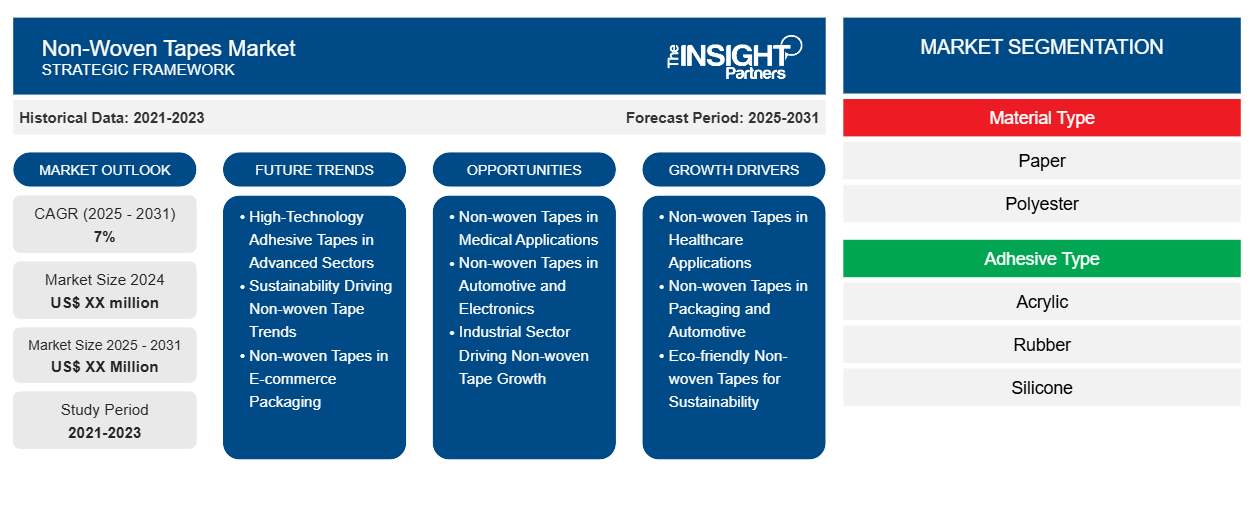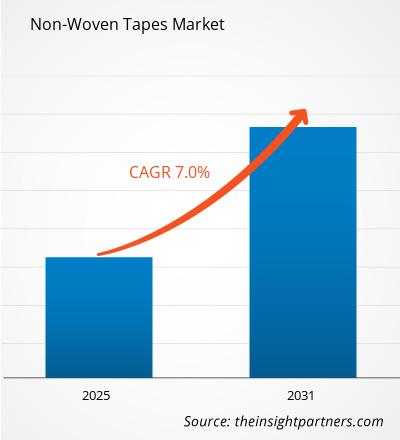Se espera que el mercado de cintas no tejidas registre una CAGR del 7% entre 2025 y 2031, con un tamaño de mercado que se expandirá de US$ XX millones en 2024 a US$ XX millones en 2031.
El mercado de cintas no tejidas se analiza por tipo de material (papel, poliéster, otros); tipo de adhesivo (acrílico, caucho, silicona); sector de aplicación (automoción y transporte, medicina, electrónica, construcción, otros) y ubicación geográfica (Norteamérica, Europa, Asia Pacífico, Oriente Medio y África, y Sudamérica y Centroamérica). La cinta no tejida está fabricada con fibras sintéticas o naturales entrelazadas térmica, mecánica o químicamente. Estas cintas se fabrican con diferentes tipos de materiales, como algodón, poliéster o papel. Las cintas no tejidas tienen un grosor relativamente bajo y se utilizan para lograr una mejor humectación y mejorar la cohesión. Se utilizan ampliamente en diversas aplicaciones, como la medicina y la higiene, entre otras.
Propósito del Informe
El informe "Mercado de Cintas No Tejidas" de The Insight Partners busca describir el panorama actual y el crecimiento futuro, los principales factores impulsores, los desafíos y las oportunidades. Esto proporcionará información a diversos actores del sector, como:
- Proveedores/Fabricantes de Tecnología: Para comprender la dinámica cambiante del mercado y conocer las oportunidades potenciales de crecimiento, lo que les permitirá tomar decisiones estratégicas informadas.
- Inversores: Realizar un análisis exhaustivo de tendencias respecto a la tasa de crecimiento del mercado, las proyecciones financieras del mercado y las oportunidades que existen en toda la cadena de valor.
- Organismos reguladores: Regular las políticas y las actividades policiales en el mercado con el objetivo de minimizar el abuso, preservar la confianza de los inversores y defender la integridad y estabilidad del mercado.
Segmentación del mercado de cintas no tejidas
Tipo de material
- Papel
- Poliéster
Tipo de adhesivo
- Acrílico
- Goma
- Silicona
Obtendrá personalización en cualquier informe, sin cargo, incluidas partes de este informe o análisis a nivel de país, paquete de datos de Excel, así como también grandes ofertas y descuentos para empresas emergentes y universidades.
Mercado de cintas no tejidas: Perspectivas estratégicas

- Obtenga las principales tendencias clave del mercado de este informe.Esta muestra GRATUITA incluirá análisis de datos, desde tendencias del mercado hasta estimaciones y pronósticos.
Factores que impulsan el crecimiento del mercado de cintas no tejidas
- Cintas no tejidas en aplicaciones sanitarias: Las cintas no tejidas se han utilizado ampliamente en el sector sanitario para el cuidado de heridas, procedimientos quirúrgicos y apósitos médicos, gracias a su transpirabilidad, suavidad e hipoalergenicidad. Por estos factores, la demanda en este mercado está creciendo significativamente debido a la demanda de personas mayores y a la fase posterior a la COVID-19.
- Cintas no tejidas en embalaje y automoción: Las cintas no tejidas ofrecen alta resistencia a la tracción, durabilidad y propiedades adhesivas. Son ideales para aplicaciones en el sector del embalaje y la automoción. Su uso se extiende a aplicaciones de sellado, aislamiento y unión debido al auge del comercio electrónico, el embalaje industrial y la producción automotriz.
- Cintas no tejidas ecológicas para la sostenibilidad: Con la sostenibilidad como prioridad, ahora se utilizan materiales biodegradables y reciclables en la fabricación de cintas no tejidas. El crecimiento en los mercados de las industrias del embalaje, la salud y la construcción muestra una mayor demanda de productos ecológicos, ya que los consumidores y las empresas buscan alternativas más ecológicas.
Tendencias futuras del mercado de cintas no tejidas
- Cintas adhesivas de alta tecnología en sectores avanzados: Las cintas adhesivas de alta tecnología desarrolladas ofrecen mayor fuerza de adhesión, flexibilidad y resistencia al calor. Esto abre las puertas a su uso en sectores de alto rendimiento como la automoción, la electrónica y la salud.
- La sostenibilidad impulsa las tendencias en cintas no tejidas: Las tendencias actuales indican que la sostenibilidad impulsará la tendencia hacia las cintas no tejidas biodegradables o compostables. Actualmente, estas cintas se fabrican con materiales renovables. Su demanda está en aumento, principalmente en las industrias del embalaje y la medicina, debido a la creciente demanda de productos más respetuosos con el medio ambiente por parte de clientes y empresas.
- Cintas no tejidas en embalajes para comercio electrónico: Debido al rápido crecimiento del sector del comercio electrónico, existe una creciente demanda de soluciones de embalaje ligeras, rentables y seguras. Estas cintas no tejidas ofrecen una gran versatilidad en aplicaciones de embalaje, por lo que su uso preferente crea nuevas oportunidades en el sector.
Oportunidades de mercado de las cintas no tejidas
- Cintas no tejidas en aplicaciones médicas: El aumento del gasto en atención médica, sumado a la creciente concienciación sobre las medidas de higiene y seguridad, representa una enorme oportunidad para las cintas no tejidas en aplicaciones médicas. Es probable que la creciente demanda de adhesivos médicos, cintas quirúrgicas y productos para el cuidado de heridas contribuya al crecimiento de este mercado dentro de la industria sanitaria.
- Cintas no tejidas en automoción y electrónica: Las cintas no tejidas se utilizan ampliamente para aislamiento, unión y sellado en aplicaciones automotrices y electrónicas, gracias a su alta resistencia, resistencia al calor y ligereza. A medida que los vehículos eléctricos y la electrónica avanzada han ganado una mayor cuota de mercado en los últimos años, el mercado de las cintas no tejidas es enorme para estas aplicaciones.
- El sector industrial impulsa el crecimiento de las cintas no tejidas: El sector industrial es un sector muy prometedor para el crecimiento de los fabricantes de cintas no tejidas debido a su durabilidad, sus fuertes propiedades adhesivas y la creciente demanda de soluciones de sellado y unión fiables, rentables y sostenibles para diversas aplicaciones, como la automoción, la construcción y el embalaje.
Perspectivas regionales del mercado de cintas no tejidas
Los analistas de The Insight Partners han explicado detalladamente las tendencias y los factores regionales que influyen en el mercado de cintas no tejidas durante el período de pronóstico. Esta sección también analiza los segmentos y la geografía del mercado de cintas no tejidas en América del Norte, Europa, Asia Pacífico, Oriente Medio y África, y América del Sur y Central.
Alcance del informe de mercado de cintas no tejidas
| Atributo del informe | Detalles |
|---|---|
| Tamaño del mercado en 2024 | US$ XX millones |
| Tamaño del mercado en 2031 | US$ XX millones |
| CAGR global (2025-2031) | 7% |
| Datos históricos | 2021-2023 |
| Período de pronóstico | 2025-2031 |
| Segmentos cubiertos | Por tipo de material
|
| Regiones y países cubiertos | América del norte
|
| Líderes del mercado y perfiles de empresas clave |
|
Densidad de actores del mercado de cintas no tejidas: comprensión de su impacto en la dinámica empresarial
El mercado de cintas no tejidas está creciendo rápidamente, impulsado por la creciente demanda del usuario final debido a factores como la evolución de las preferencias del consumidor, los avances tecnológicos y un mayor conocimiento de los beneficios del producto. A medida que aumenta la demanda, las empresas amplían su oferta, innovan para satisfacer las necesidades del consumidor y aprovechan las tendencias emergentes, lo que impulsa aún más el crecimiento del mercado.

- Obtenga una descripción general de los principales actores clave del mercado de cintas no tejidas
Puntos clave de venta
- Cobertura integral: el informe cubre de manera integral el análisis de productos, servicios, tipos y usuarios finales del mercado de cintas no tejidas, proporcionando un panorama holístico.
- Análisis de expertos: el informe se compila con base en el conocimiento profundo de expertos y analistas de la industria.
- Información actualizada: El informe asegura relevancia comercial debido a su cobertura de información reciente y tendencias de datos.
- Opciones de personalización: este informe se puede personalizar para satisfacer los requisitos específicos del cliente y adaptarse adecuadamente a las estrategias comerciales.
Por lo tanto, el informe de investigación sobre el mercado de cintas no tejidas puede ayudar a descifrar y comprender el panorama de la industria y sus perspectivas de crecimiento. Si bien existen algunas preocupaciones válidas, las ventajas generales de este informe suelen superar las desventajas.
- Análisis histórico (2 años), año base, pronóstico (7 años) con CAGR
- Análisis PEST y FODA
- Tamaño del mercado, valor/volumen: global, regional y nacional
- Industria y panorama competitivo
- Conjunto de datos de Excel
Informes recientes
Testimonios
Razón para comprar
- Toma de decisiones informada
- Comprensión de la dinámica del mercado
- Análisis competitivo
- Información sobre clientes
- Pronósticos del mercado
- Mitigación de riesgos
- Planificación estratégica
- Justificación de la inversión
- Identificación de mercados emergentes
- Mejora de las estrategias de marketing
- Impulso de la eficiencia operativa
- Alineación con las tendencias regulatorias






















 Obtenga una muestra gratuita para - Mercado de cintas no tejidas
Obtenga una muestra gratuita para - Mercado de cintas no tejidas